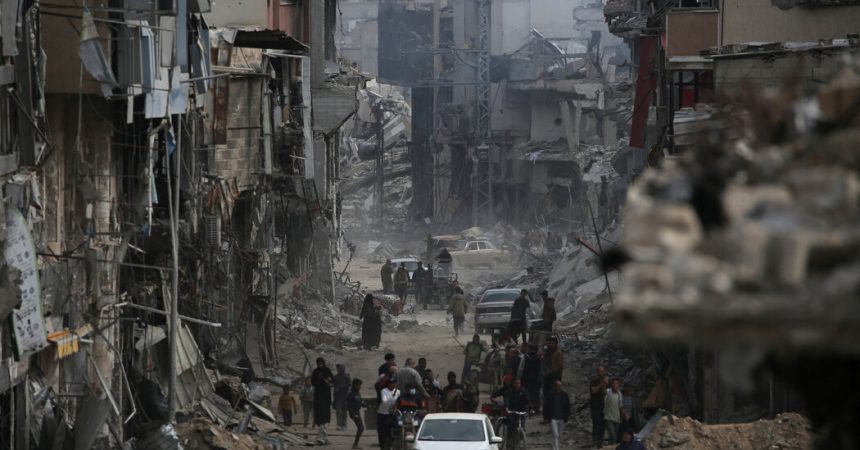The Israeli military’s departure from southern Gaza over the weekend has left the devastated territory in a state of suspense as active fighting there receded on Monday to its lowest ebb since a brief truce with Hamas in November.
But even as some observers hoped Israel’s withdrawal from the area might portend a new cease-fire, both Hamas and Israeli officials suggested the war was not yet over.
Analysts said the withdrawal of Israeli troops suggested only that the war had entered a new phase, one in which Israel would continue to mount small-scale operations across Gaza to prevent Hamas’s resurgence. That strategy, they said, could occupy a middle ground between reaching a lasting truce with Hamas and ordering a major ground assault into Rafah, Hamas’s last stronghold in southern Gaza where more than one million Palestinians have taken refuge.
In a statement on Monday, Prime Minister Benjamin Netanyahu of Israel said that while Israel was still pursuing a deal to secure the release of its hostages in Gaza, it was also seeking “total victory over Hamas.”
“This victory requires entering Rafah and eliminating the terrorist battalions there,” Mr. Netanyahu said. “This will happen; there is a date.” He did not specify the date.
By withdrawing now without having fulfilled its stated mission of eliminating Hamas and without empowering an alternative Palestinian leadership, Israel has left behind a power vacuum in Gaza, in which Hamas could regroup and re-emerge as a military force across much of the territory.
The Israeli military said on Sunday that its 98th Division had left Khan Younis in southern Gaza in order “to recuperate and prepare for future operations.” That leaves no Israeli troops actively maneuvering in southern Gaza, according to two officials briefed on the matter who were not authorized to speak publicly about it.
The Israeli leadership painted the withdrawal as a sign of Israel’s progress on the battlefield, and something it had long predicted. Israeli officials have said they would eventually move most troops back to the strip’s perimeter and conduct brief attacks on specific targets, instead of carrying out large-scale ground maneuvers across wide areas.
The drawdown continues a process that began in January and leaves the equivalent of a single brigade in all of Gaza, or fewer than 5,000 troops — down from roughly 50,000 at the height of the war in December.
The 98th Division’s operations in southern Gaza were “extremely impressive,” the Israeli defense minister, Yoav Gallant, said in a statement. “Their activities enabled the dismantling of Hamas as a functioning military unit in this area,” he added.
The remaining troops inside Gaza are mostly guarding a buffer zone that Israel has created by destroying Palestinian buildings along the border, or are positioned along a narrow land corridor that splits northern Gaza, including Gaza City, from the rest of the territory.
Two journalists for The New York Times traveled along the corridor last week, observing how it functions as a supply road for troops, a barrier to displaced Gazans attempting to move back to north Gaza and a potential launchpad for future Israeli military operations in northern and central Gaza.
To critics of the military’s decision, the drawdown constitutes an Israeli failure. Despite mounting a campaign that the local authorities say has killed more than 33,000 and left Gaza in ruins and on the brink of famine, Israel is leaving most of the strip without having achieved the goals it set for itself after Hamas raided Israel on Oct. 7, killing about 1,200 people and setting off the war.
Hamas’s most senior leaders are still alive; several thousand Hamas fighters are still at large; and roughly half of the hostages taken on Oct. 7 are still in Gaza. Israel’s withdrawal has left most of Gaza without a functional administration, and the void could be filled once more by Hamas.
“In the six months of war, we failed to achieve even a single one of the objectives,” wrote Nahum Barnea, a prominent Israeli commentator, in a column on Monday for the centrist news outlet Yediot Ahronot. “We did not destroy Hamas,” he added.
For Palestinians returning to their homes after the Israeli withdrawal, there was a sense of horror as they grasped the scale of destruction in their neighborhoods.
“Destruction is everywhere,” said Akram Al-Satri, 47, a freelance journalist who is not employed by The New York Times and who said he returned on Monday morning to his wrecked neighborhood in Khan Younis.
“People were looking for their beloveds under the rubble; others were looking for their belongings or anything that they can use now,” Mr. Al-Satri said in a phone interview. “I saw people finding decomposed human parts and trying to recognize who they were by their clothes.”
Dr. Ahmad al-Farra, 54, who ran the pediatric ward at Nasser Hospital in Khan Younis before his family fled south to Rafah in January, said his family went back to their three-story villa on Sunday and found it reduced to rubble, surrounded by a few trees that were left standing in what was once a lush garden.
“I completely collapsed and nearly fainted,” he said in a phone call on Monday, adding that his wife and two teenage daughters burst into tears.
“I worked for 20 years to build this house,” Dr. al-Farra said. “You build a home corner by corner, stone by stone.”
“And in the end,” he added, “with a press of a button, it is reduced to rubble.”
He and others fear that Israel will send ground troops into Rafah in pursuit of Hamas’s leaders and fighters once the Muslim holy month of Ramadan ends this week.
“The dreams of an entire family have disappeared into the air,” Dr. al-Farra said. “Where will we go now? Will we spend the rest of our lives living in tents?”
To thoroughly rout Hamas, Israel would need to follow through on its promise to advance on Rafah, where most of Hamas’s remaining fighters and military leaders are thought to be hiding.
Mr. Netanyahu faces intense pressure from far-right members of his ruling coalition to proceed with the Rafah operation. Some of those lawmakers have threatened to collapse Mr. Netanyahu’s coalition government should he call off a ground invasion, prompting elections that the prime minister could lose.
The prime minister is also under growing international pressure, including from President Biden, to resist invading Rafah because it would risk widespread harm to civilians who have fled to the city since the war began.
And Mr. Netanyahu faces a growing domestic backlash from Israelis who believe he should secure the swift release of the remaining hostages, even if it comes at the cost of keeping Hamas in power.
The Biden administration said Monday that a new cease-fire and hostage-release proposal had been presented to Hamas.
“We really want to come to closure on a hostage deal as soon as possible,” John F. Kirby, a White House national security spokesman, told reporters. He added that a deal would come with “a cease-fire of some weeks duration, hopefully around six weeks.”
Basem Naim, a Hamas spokesman, said on Monday that the latest proposal was “worse than the previous ones.”
Among other sticking points, he said: “They are not mentioning the withdrawal of troops from Gaza. They are saying nothing on permanent cease-fire.” There has been “some progress,” he said, on a proposal to allow displaced Gazans to return to their homes.
“This offer cannot be a starting point to reaching a cease-fire agreement,” he said in an interview.
Negotiations have stalled for months, in large part because Israel does not want to agree to a truce that allows Hamas to remain in charge of any part of Gaza, while Hamas is wary of a deal that does not provide for the release of as many members as possible from Israeli prisons or that does not ensure its long-term survival.
Reporting was contributed by Hiba Yazbek, Abu Bakr Bashir, Johnatan Reiss and Katie Rogers.







